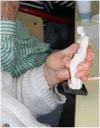Museum Moving to Inpatients: Le Louvre à l'Hôpital
- PMID: 30642107
- PMCID: PMC6352230
- DOI: 10.3390/ijerph16020206
Museum Moving to Inpatients: Le Louvre à l'Hôpital
Abstract
Anxiety and depressive symptoms are common in hospitalized patients. Arts and cultural programs were reported to enhance their quality of life. The Le Louvre à l'hôpital study presents a new approach in which the museum moves to the hospital by displaying and discussing artworks with patients interactively. Over one year, four large statues were disposed in the hospital gardens, 30 reprints of large painting were exhibited in the hospital hall, dining rooms, and circulations areas. A total of 83 small-group guided art discussions (90 min) were organized, which 451 patients attended. The 200 small-size reproductions of paintings placed in the patients' rooms were chosen based on their individual preferences. Decreased anxiety after the art sessions was reported by 160 of 201 patients (79.6%). Out of 451 patients, 406 (90%) said the art program had met their expectations, and 372 (82.4%) wished to continue the experience with caregivers (162 paramedics trained for art activity during 66 workshops). In conclusion, moving the museum to the hospital constitutes a valuable way to provide art activities for inpatients in large numbers, which may reduce hospital-related anxiety in many instances.
Keywords: art therapy; hospital-related stress; museum.
Conflict of interest statement
The authors declare no conflict of interest.
Figures
References
MeSH terms
LinkOut - more resources
Full Text Sources
Medical
Miscellaneous



